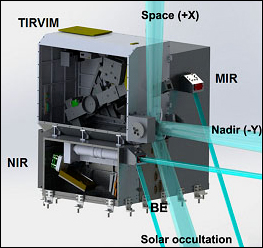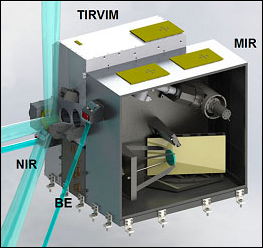Principal Investigator: Korablev O.
Project Manager: Shakun A.
MIR and NIR Technical Manager: Trokhimovsky A.
TIRVIM Technical Manager: Grigoriev A.
ACS is the set of three spectrometers being built in Space research Institute (IKI) in Moscow, Russia. Its design capitalizes on the previous developments of high-technology readiness: two instruments built for the unsuccessful Phobos-Grunt project 9–11 and one instrument flown at the International Space Station (ISS) in 2009–2012.
Some components/subsystems were contributed by the German Institut für Planetenforschung (DLR) and LATMOS (CNRS) in France.
ACS includes three separate spectrometers, sharing common mechanical, thermal, and electrical interfaces. On the TGO spacecraft, the instrument occupies the slot at the upper deck, previously devoted to MATMOS. The ACS architecture and its concept design are shown in Fig. 1.
|
 |
 |
|
Fig. 1 The concept design of ACS. Suite consists of four blocks: the NIR channel, the MIR channel, the TIRVIM channel, and the electronic block. The yellow blocks designate the instrument’s radiators. The pointing directions of the ACS channels are shown. |
Near-Infrared Channel (NIR)
The ACS NIR channel employs the scheme of solar occultation infrared (SOIR), a combination of an echelle spectrometer and an acousto-optic tunable filter (AOTF) for the selection of diffraction orders. This scheme was originally proposed and prototyped for the measurements in the terrestrial atmosphere, and first implemented in space for the case of Venus.
NOMAD on TGO employs the same principle and actually consists of two SOIR-type spectrometers, one optimized for solar occultation, and another for nadir. The closest analog of NIR is the RUSALKA instrument (Russian acronym for manual spectral analyzer of the atmosphere constituents), flown on the ISS in 2009–2012.
RUSALKA covered the spectral range of 0.7–1.65 μm with the resolving power of 20,000, and demonstrated measurements of terrestrial CO2 and CH4 in nadir. However, cosmonauts operated RUSALKA in the habitable compartment of the ISS, and the instrument was built according to these requirements, which are very different from those on a deep space mission. ACS NIR is the adaptation of the RUSALKA design for autonomous operation in open space with several amendments aimed to improve the sensitivity and the optical quality of the instrument.
ACS NIR is able to perform nadir and occultation observations using two FOVs, which are combined inside the instrument.
Mid-Infrared Channel (MIR)
The MIR channel is a cross dispersion spectrometer working in the 2.3–4.2 μm spectral range, and simultaneously covering up to 300 nm per measurement. With a cross dispersion concept, the echelle orders are dispersed along the x-axis and separated along the y-axis of the focal plane by a secondary dispersion element, making full use of the two dimensions of the detector array. Acquisition of the wide wavelength domain at once provides a strategic advantage for maximizing the number of gaseous species simultaneously mapped. The concept of the cross dispersion echelle instrument, which is widely accepted in astronomy, has already been employed in planetary missions with visible and infraRed thermal imaging spectrometers, with high resolution (VIRTIS-H) instruments presently in flight on Rosetta and Venus Express missions. The concept of VIRTIS-H consists of acquiring a broad spectral range of 2–5 μm instantaneously at the 2-D detector using the echelle grating and a prism. With number of diffraction orders of 10, the resolving power of VIRTIS-H is λ∕Δλ ≈ 2000.
Targeting much a higher resolving power than that of VIRTIS-H, and a broader instantaneous spectral range than that of SOIR-type echelle-AOTF instruments, we conceived a new type of optical scheme: a cross dispersion echelle spectrometer with a movable secondary dispersion element. This concept allows us to achieve high spectral resolution instantaneously in a large number of adjacent diffraction orders (from 10 to 30 in our case), covering only a fraction of the full spectral range. A moving dispersion element allows the instrument to switch from one group of diffraction orders to another prior to a series of measurements, or alternates between two desired positions during one measurement sequence.
Targeting very high spectral resolution, the MIR channel operates in solar occultation only.
Thermal-Infrared Channel (TIRVIM)
In contrast to NIR and MIR abbreviations, which are self-explicit, TIRVIM stands for thermal infrared V-shape interferometer mounting, but also commemorates the initials of Vassilii Ivanovich Moroz, the IR astronomer and the leader of the planetary school in IKI during 1968–2004, who introduced the Fourier-transform spectrometers and pursued their development in this institution.
TIRVIM is a 2-inch double pendulum Fourier-transform spectrometer for the spectral range of 1.7–17 μm. It has three detectors, allowing operation in four different operation modes.. The primary scientific goal of TIRVIM is the monitoring of atmospheric temperatures and aerosol states in nadir. The instrument capitalizes on previous developments of IKI in Fourier spectrometers. One detector (longwave, LW) is sensitive at 1.7–17 μm, another (shortwave, SW) at 2.2–3.5 μm. The LW detector is employed both in nadir and in solar occultation, allowing spectral resolution of 1.6 cm−1 and 0.2 cm−1, respectively. The SW detector optimized for the 3-μm range targets the mapping of minor gases in nadir with the best spectral resolution of 0.5 cm−1. An additional pyroelectric detector operates at ambient temperature in the 1.7–25 μm range.
Publications:
1. Korablev, Oleg; Trokhimovsky, Alexander; Grigoriev, Alexei V.; Shakun, Alexei; Ivanov, Yuriy S.; Moshkin, Boris; Anufreychik, Konstantin; Timonin, Denis; Dziuban, Ilia; Kalinnikov, Yurii K.; Montmessin, Franck, Three infrared spectrometers, an atmospheric chemistry suite for the ExoMars 2016 trace gas orbiter, Journal of Applied Remote Sensing, Volume 8, id. 084983 (2014)
2. Korablev, Oleg; Grigoriev, Alexei V.; Trokhimovsky, Alexander; Ivanov, Yurii S.; Moshkin, Boris; Shakun, Alexei; Dziuban, Ilia; Kalinnikov, Yurii K.; Montmessin, Franck Atmospheric chemistry suite (ACS): a set of infrared spectrometers for atmospheric measurements on board ExoMars trace gas orbiter, Proceedings of the SPIE, Volume 8867, id. 886709 12 pp. (2013).
Conferences:
1. Trokhimovskiy A., Oleg Korablev, Yurii Ivanov, Ivan Syniavskyi, Franck Montmessin, Anna Fedorova, HIGH RESOLUTION MIDDLE INFRARED SPECTROMETER, A PART OF ATMOSPHERIC CHEMISTRY SUITE (ACS) FOR EXOMARS 2016 TRACE GAS ORBITER, International Conference on Space Optics, 7-10 October 2014, Tenerife, Spain.
2. Korablev O., Franck Montmessin, Anna Fedorova, Nikolay Ignatiev, Alexander Trokhimovskiy, Alexei Grigoriev, Alexey Shakun, Development of Atmospheric Chemistry Suite (ACS) for ExoMars: Three IR Spectrometers to Characterize the Atmosphere and Climate 40th COSPAR Scientific Assembly 2014, B0.2-0020-14, 2014.
3. Trokhimovskiy, A.; Korablev, O.; Grigoriev, A.; Fedorova, A.; Shakun, A.; Ignatiev, N.; Zasova, L.; Moshkin, B.; Dziuban, I.; Guslyakova, S.; Anufreychik, K.; Stepanov, A.; Titov, A.; Montmessin, F.; Ivanov, Y.; Kalinnikov, Y.; ACS Team; Atmospheric Chemistry Suite (ACS): a set of Infrared Spectrometers for Atmospheric Measurements on Board ExoMars Trace Gas Orbiter, The Fifth International Workshop on the Mars Atmosphere: Modelling and Observation, held on January 13-16 2014, in Oxford, U.K. Edited by F. Forget and M. Millour, id.4402.
4. Трохимовский А. Ю., Кораблев О. И., Григорьев А. В., Шакун А. В., Федорова А. А., Дзюбан И. А. Создание спектрометрического комплекса АЦС для российско-европейского проекта «ЭкзоМарс-2016», 11я всероссийская открытая ежегодная конференция «Современные проблемы дистанционного зондирования Земли из космоса» (Физические основы, методы и технологии мониторинга окружающей среды, природных и антропогенных объектов), Москва, ИКИ РАН, 11-15 ноября 2013 г.
5. Трохимовский А.Ю., Кораблев О.И., Григорьев А.Г., Шакун А.И., Федорова А.А., Дзюбан И.А., Гуслякова С.А., Разработка комплекса приборов ACS (Atmospheric Chemistry Suit) для исследования химического состава атмосферы и климата Марса на борту «Экзомарс» (Trace Gas Orbiter), Десятая всероссийская открытая ежегодная конференция «Современные проблемы дистанционного зондирования Земли из космоса» (Физические основы, методы и технологии мониторинга окружающей среды, природных и антропогенных объектов)Москва, ИКИ РАН, 12-16 ноября 2012 г.
6. Korablev, Oleg; Bertaux, Jean-Loup; Goutail, Jean Pierre; Trokhimovskiy, Alexander; Montmessin, Franck; Grigoriev, Alexei; Shakun, Alexei Atmospheric Chemistry Suite (ACS): an instrument to measure the atmosphere composition and structure for ExoMars Trace Gas Orbiter (2016) 39th COSPAR Scientific Assembly. Held 14-22 July 2012, in Mysore, India. Abstract E2.6-22-12, p.969
|